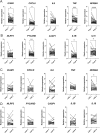Different expression patterns of inflammation-related genes and serum microRNAs in young-onset ischemic stroke
- PMID: 39394477
- PMCID: PMC11470008
- DOI: 10.1038/s41598-024-74995-0
Different expression patterns of inflammation-related genes and serum microRNAs in young-onset ischemic stroke
Abstract
Brain ischemia results in the activation of a cascade of inflammatory responses, contributing to the pathogenesis of stroke. This study aimed to assess the patterns of possible changes in the expression of specific inflammation-associated protein-encoding genes and miRNAs in the peripheral blood between the acute and chronic phase of young-onset cryptogenic (Cryp) and large-artery atherosclerotic (LAA) stroke. Blood and serum were collected from patients with cryptogenic and large-artery atherosclerotic stroke at the stroke onset and 1-year follow-up. The relative expression of inflammation-related genes was analysed at the mRNA and miRNA levels using real-time quantitative PCR. Moreover, the relationship between the relative gene expression levels and clinical data was assessed using several different statistical approaches. Seventy-three patients were included in this study, with a median age of 47 (IQR, 9) years. Approximately 72% were men. In patients with cryptogenic stroke, at the mRNA level, ICAM1, CXCL8, TNF, NFKBIA, PYCARD, IL1B, and IL18 were observed to be upregulated at the stroke onset compared to the 1-year follow-up. In patients with LAA stroke, only the expression of NFKBIA was significantly higher during acute stroke. Further, the miRNA serum levels of miR-21, miR-122, and miR-155 were higher at the onset of stroke in patients with cryptogenic stroke but not in those with LAA stroke. The differences between the relative gene expression levels during acute stroke and at the 1-year follow-up were more pronounced in patients with cryptogenic stroke with no cardiovascular risk factors. The expression changes of inflammatory genes in whole blood and miRNAs in the serum differ in patients with cryptogenic and LAA stroke.
© 2024. The Author(s).
Conflict of interest statement
The authors declare no competing interests.
Figures


References
-
- Yesilot Barlas, N. et al. Etiology of first-ever ischaemic stroke in European young adults: The 15 cities young stroke study. Eur. J. Neurol. 20, 1431–1439 (2013). - PubMed
-
- Putaala, J. et al. Analysis of 1008 consecutive patients aged 15 to 49 with first-ever ischemic stroke the Helsinki young stroke registry. Stroke 40, 1195–1203 (2009). - PubMed
MeSH terms
Substances
Grants and funding
LinkOut - more resources
Full Text Sources
Medical
Miscellaneous

